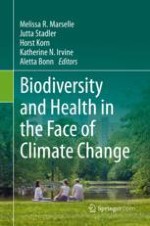The available evidence on the effects of green spaces on asthma and allergic conditions in children is inconsistent (Lambert et al.
2017). While a number of studies have reported a higher risk of allergic conditions and exacerbation of asthma in children in relation to green spaces (Dadvand et al.
2014a; DellaValle et al.
2012; Fuertes et al.
2016; Lovasi et al.
2013), others have shown no or even protective associations (Dadvand et al.
2014a; Fuertes et al.
2016; Hanski et al.
2012; Lovasi et al.
2008; Müller-Rompa et al.
2018; Pilat et al.
2012; Tischer et al.
2017,
2018). These inconsistencies reflect the potential conflicting functions of green spaces in relation to these health outcomes. For example, green spaces can increase the risk of asthma and allergic conditions through releasing allergic pollens (DellaValle et al.
2012; Lovasi et al.
2013) and fungal spores (Bartra et al.
2009; De Linares et al.
2010), or through pesticides or fertilisers used for green space maintenance (Corsini et al.
2012; see also Damialis et al. Chap.
3, this volume). On the other hand, green spaces can prevent these conditions through enriching environmental biodiversity, mitigating exposure to air pollution and, to a lesser extent, encouraging physical activity and reducing the risk of obesity (Hanski et al.
2012; Lovasi et al.
2008; Pilat et al.
2012). The heterogeneity in the available literature could also have been, in part, due to the poor metrics that did not take into account the differential allergenicity of different vegetation species or seasonal variation in their allergenic properties. Different types of green spaces (e.g. parks vs. forests) and different climates/settings could also be contributing factors to such a heterogeneity. For example, a study from Spain reported that residing close to urban parks was associated with a higher risk of concurrent asthma and allergic rhinoconjunctivitis, while residing close to natural green spaces (e.g. forests) was not (Dadvand et al.
2014a). Another study that evaluated the impacts of green spaces on respiratory outcomes reported different impacts across two bio-geographic regions in Spain (Tischer et al.
2017). In the Euro-Siberian region, characterised by a humid climate with water availability throughout the year, cold winters and maximum vegetation during summer months (Alcaraz-Segura et al.
2009), green spaces were negatively associated with wheezing. In the Mediterranean region, characterised by an arid climate with hot and dry summers, mild and rainy winters, and maximum vegetation between autumn and spring (Alcaraz-Segura et al.
2009), living closer to green spaces was associated with a reduced risk of bronchitis. Similarly, a study including seven birth cohorts from across Europe, Australia and Canada has reported heterogeneous associations for different regions (Fuertes et al.
2016). While the association between green spaces and allergic rhinitis was positive in Sweden and Southern Germany, it was negative in Northern Germany and the Netherlands. For the Australian and two Canadian cohorts, no associations were observed. A similar pattern was observed for aeroallergen sensitisation (Fuertes et al.
2016). Further research with more refined green space assessment is warranted in this field.
